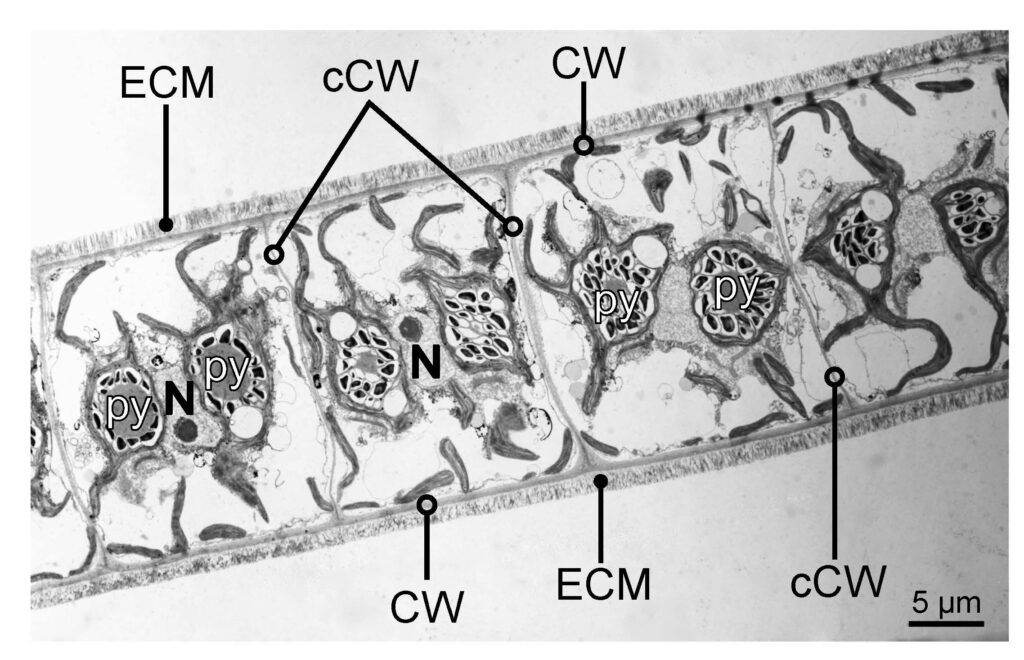Research uncovers the genetic foundations that helped plants conquer land over 600 million years ago.

Transmission Electron Microscopy shows the longitudinal section of a single filament of Z. circumcarinatum SAG 698-1b. The algal cells are connected with very thin cross cell walls (cCW). The cell wall (CW) is surrounded by a thick extracellular matrix (ECM). Pyrenoids: Py, Nucleus: N. Scale bar: 5 μm. [Image Credit: Elke Woelken and Klaus von Schwartzenberg, University of Hamburg]
The Science
By studying the genes of land plants’ closest algal relative, Zygnematophyceae, scientists have enhanced our understanding of how early plants transitioned from water to land. Key gene groups involved in stress tolerance and multicellularity enabled plants to develop complex structures and adapt to changing environments — ultimately allowing them to adapt to life on land. Learning that these genetic tools existed in close algal relatives to terrestrial plants showcases how early plants built upon an ancient genetic framework to thrive outside aquatic environments.
The Impact
A deeper understanding of how plants adapted to terrestrial life paves the way for innovations in sustainable agriculture and clean energy. These evolutionary strategies that helped plants thrive under challenging conditions could inform the development of resilient crop varieties able to grow in marginal lands and with minimal resources. Enabling the use of non-arable land for biomass production — that can be converted into biofuels and bioproducts — would further drive a strong bioeconomy.
Summary
Through the Community Science Program of the U.S. Department of Energy (DOE) Joint Genome Institute (JGI), a DOE Office of Science User Facility located at Lawrence Berkeley National Laboratory (Berkeley Lab), scientists sequenced the genomes of four Zygnematophyceae algae, which were isolated from diverse freshwater environments. Arising in tandem from the same ancestor, these algae are considered sisters to land plants, based on shared genetic traits and evolutionary lineage. They provide a unique window into the adaptations that enabled the first land plants to transition to terrestrial life.
These led to highly detailed assemblies for three strains of Zygnema circumcarinatum. Published May 2024 in Nature Genetics by an international research consortium led by the University of Nebraska-Lincoln and University of Goettingen, this research provides critical insights into the common ancestry of these algae and land plants.
Researchers identified key genes associated with stress responses and compared them with those found in modern plants. They discovered that ancient algae already possessed genetic tools to cope with environmental stresses such as drought and nutrient scarcity, suggesting the evolutionary lineage leading to land plants is more complex than previously thought.
The researchers found that Zygnematophyceae share key genes with land plants for making and modifying cell walls, a feature crucial for surviving on land. They also discovered that genes involved in growth and stress responses are interconnected, suggesting that this genetic network was already in place in ancient algae. Essentially, even before the first plants appeared on land, these algae had a genetic toolkit for multicellular growth with plant-like cell walls and environmental response.
These results suggest that the evolution of complex bodies and the ability to adapt to different environments were deeply rooted in the common ancestor of algae and land plants. The research provides a better understanding of plant evolution and could lead to advancements in improving plant resilience and productivity. The algal genomes sequences are available on the JGI’s PhycoCosm portal.
Contact
Jan de Vries
University of Goettingen
[email protected]
Yanbin Yin
University of Nebraska-Lincoln
[email protected]
Funding
This work was funded by the US National Science Foundation (NSF) CAREER award (DBI-1652164, 1933521), the Nebraska Tobacco Settlement Biomedical Research Enhancement Funds as part of a startup grant of the University of Nebraska Lincoln, the Research & Artistry Award of Northern Illinois University, the Joint Genome Institute Community Science Program (CSP), the United States Department of Agriculture (USDA) award (58-8042-9–089), the National Institutes of Health (NIH) awards (R21AI171952) and (R01GM140370) all to Y.Y., and by the German Research Foundation grant 440231723 (VR 132/4-1) to J.d.V., TH417/12-1 to G.T. and F.R., and 440540015 (BU 2301/6-1) to H.B. within the framework of the Priority Programme ‘MAdLand – Molecular Adaptation to Land: Plant Evolution to Change’ (SPP 2237), and grant 410739858 in the frame of the project CharMod to K.v.S., as well as RE 1697/16-1 (CharMod) and 18-1 (CharKeyS) to S.A.R. J.d.V. further thanks the European Research Council for funding under the European Union’s Horizon 2020 research and innovation program (grant agreement no. 852725; ERC-StG ‘TerreStriAL’). The work was further supported by Austrian Science Fund (FWF) project 10.55776/P34181 to A.H. The work (proposal: 10.46936/10.25585/60001088) conducted by the US Department of Energy Joint Genome Institute (https://ror.org/04xm1d337), a DOE Office of Science User Facility, is supported by the Office of Science of the US Department of Energy operated under contract no. DE-AC02-05CH11231. P.-M.D is supported by the project Engineering Nitrogen Symbiosis for Africa (ENSA) currently funded through a grant to the University of Cambridge by the Bill & Melinda Gates Foundation (OPP1172165) and the UK Foreign, Commonwealth and Development Office as Engineering Nitrogen Symbiosis for Africa (OPP1172165), by the ‘Laboratoires d’Excellence (LABEX)’ TULIP (ANR-10-LABX-41)’ and by the European Research Council (ERC) under the European Union’s Horizon 2020 research and innovation program (grant agreement no. 101001675).
Publication
- Feng, X., Zheng, J., Irisarri, I. et al. Genomes of multicellular algal sisters to land plants illuminate signaling network evolution. Nat Genet 56, 1018–1031 (2024). [DOI: 10.1038/s41588-024-01737-3]
Relevant Links:
- Zygnema on PhycoCosm
- Nature Plants Research Highlight: “Two Steps Beyond”